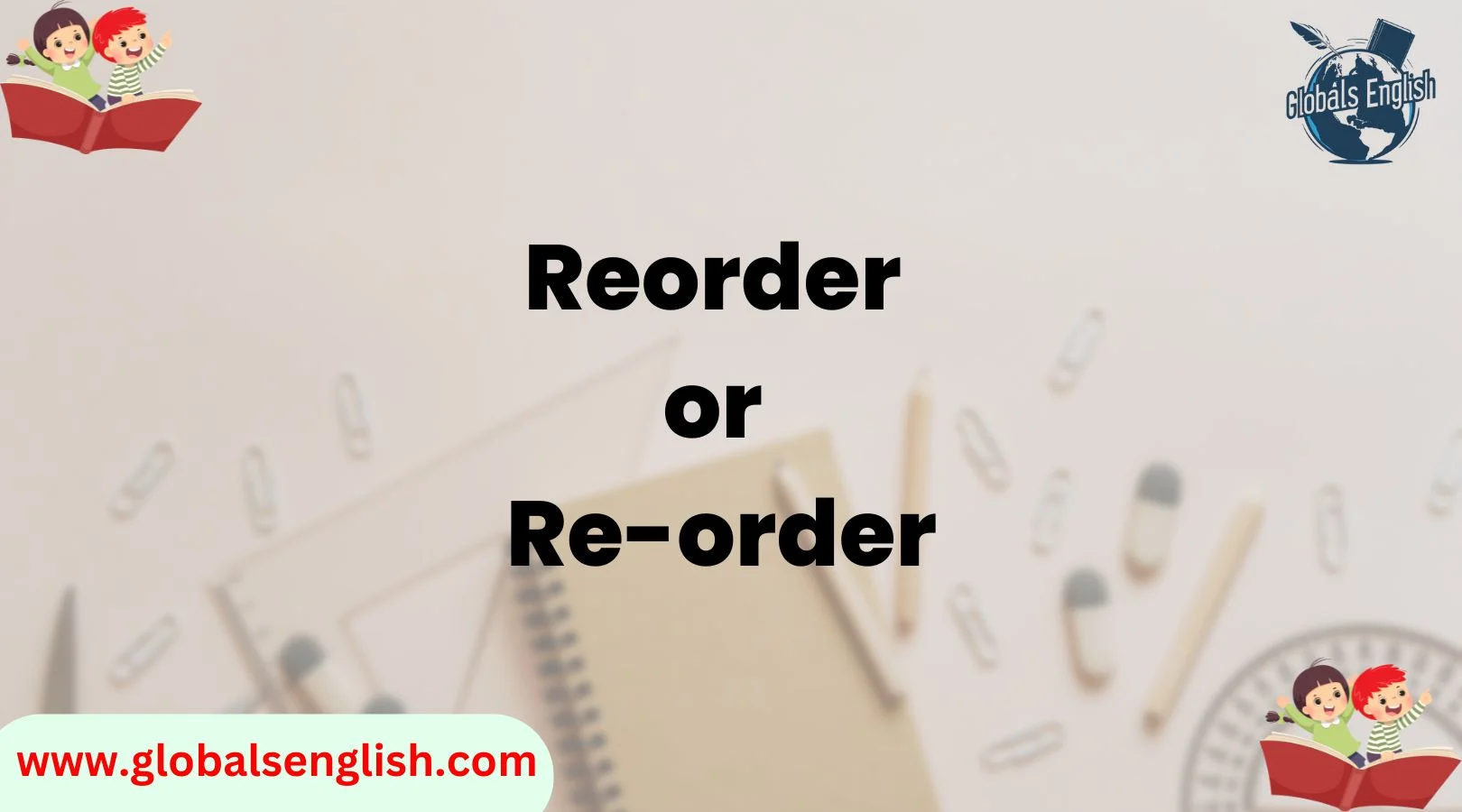In the vast world of the English language, some questions remain persistently perplexing. One such question is whether to use “reorder” or “re-order”. If you’ve ever hesitated to type that second hyphen or wondered whether one form is right and the other wrong, you’re not alone.
It’s a confusion that many English speakers, both native and non-native, encounter. While some may brush it off as a minor detail, understanding when and why to use hyphens can make your writing clearer and more professional.
This article aims to unravel the mystery behind “reorder” vs. “re-order”, providing you with an in-depth understanding of the hyphenation rules that apply to compound words in American English.
We’ll explore the historical background, the specific rules governing hyphenation, and offer practical tips to help you confidently choose between the two forms. So, let’s dive into the heart of the matter and eliminate the confusion once and for all.
What Most People Think vs. What the Rules Say
Common Assumptions About Hyphenation
Many people believe that adding a hyphen to certain words is optional or, at the very least, a matter of personal preference. You may have heard someone say, “Reorder is fine without the hyphen,” and assumed it’s just a stylistic choice. However, the reality is far more structured than this.
In American English, the use of hyphens in compound words often follows specific grammatical rules. The decision to use a hyphen is not just about aesthetics but about clarity, readability, and following established conventions.
When it comes to “reorder” vs. “re-order”, the correct choice depends on whether the term is being used as a verb or an adjective. This distinction helps to explain why one form is often more acceptable than the other.
The Key Rule: The Compound Verb vs. The Adjective
A major point of confusion lies in whether a hyphen should be used when “re-“ is added to a base word. In this case, the term “re-“ serves as a prefix that means “again” or “back,” modifying the base word. The rule to remember is that if the compound word functions as a verb, you usually don’t need a hyphen.
For example:
- “Reorder” (as in, “I need to reorder my supplies.”) is a verb. No hyphen is required.
- “Re-order” (as in, “We have to re-order the goods.”) is less common but may be used if you want to clarify the intended meaning in certain contexts.
When Do You Need a Hyphen?
Hyphenation in Compound Adjectives
One of the most important reasons to use a hyphen is when the compound word functions as an adjective before a noun. The hyphen helps clarify that the two words work together to describe the noun, rather than being two separate elements.
For example:
- Re-orderable system (You can reorder it. It’s a system that can be reordered.)
In these instances, the hyphen helps ensure the meaning is clear. Without it, the meaning could be confused, especially in complex sentences where ambiguity might arise.
When Hyphens Aren’t Needed
However, if the compound adjective comes after the noun, you typically won’t need a hyphen. For example:
- The system is reorderable. Here, the adjective is not directly before the noun, so no hyphen is necessary.
The Historical Roots of the Re-order Debate
Tracing the Evolution of “Reorder”
The evolution of hyphenation in English can be traced back to the earliest written forms of the language. Hyphens were originally introduced to clarify meaning in compound words that could otherwise be confusing. Over time, the use of hyphens in compound words became more standardized in modern English, particularly for terms involving prefixes like “re-“, “un-“, and “in-“.
Interestingly, the use of the hyphen in “re-order” used to be far more common in earlier centuries. In fact, during the 18th and 19th centuries, it was standard practice to add a hyphen to compound verbs such as “re-order” and “re-build.”
But over time, as the language evolved, simplification became the norm, and “reorder” gradually gained more widespread acceptance as the standard form.
How Modern Usage Has Changed
In the 20th and 21st centuries, most major English style guides (such as The Chicago Manual of Style and Merriam-Webster’s Dictionary) have largely dropped the hyphen in compound verbs. This shift reflects the trend toward simplification in modern English, where fewer hyphens are used in compound words.
The Role of Hyphens in Readability and Clarity
Hyphens Improve Reading Flow
Hyphens are not just a matter of grammatical convention; they can also enhance readability. Proper hyphenation helps readers quickly recognize compound words and understand how they function within a sentence. Without hyphens, the sentence might become harder to process or lead to multiple interpretations.
For example:
- “I will re-order my schedule” is easier to read than “I will reorder my schedule” when both words work together to clarify action. The hyphen improves the clarity of the message, even if the non-hyphenated version is also grammatically correct.
Avoiding Ambiguity
In some cases, failing to use a hyphen can lead to ambiguity. For instance, consider the following example:
- Re-order the meeting or reorder the meeting? In this context, “re-order” can indicate that the meeting is being reorganized or rescheduled, while “reorder” could imply that the schedule itself is being rearranged. The hyphen adds clarity to the action being described.
When to Use “Reorder” vs. “Re-order” in Professional Writing
In Business and Academic Settings
In professional writing, clarity is key. The difference between “reorder” and “re-order” can sometimes affect how ideas are communicated. In business documents, product descriptions, or academic writing, it’s essential to use the correct form to ensure your message is precise.
- “Reorder” is generally more commonly used and is the preferred form in most business contexts.
- “Re-order” might be used when emphasis is needed, or when writing for a more specific, technical audience.
Avoiding Overuse of Hyphens
While hyphens are useful in certain cases, overuse can detract from readability. Excessive hyphenation can make the writing appear cluttered or confusing. Instead, use hyphens sparingly and only when they are necessary to clarify meaning.
Why Some People Still Use “Re-order”
The Case for Consistency
Some people, particularly those in legal, technical, or scientific fields, still prefer to use “re-order” for consistency’s sake. If other compound words in their writing adhere to a hyphenation pattern, they may opt for “re-order” to maintain uniformity.
For instance:
- In technical writing, where precision is paramount, it might be better to follow a consistent style guide that prefers the hyphenated form for all compound verbs.
Regional Preferences and Variations
In certain regions or industries, the use of “re-order” might be more common. British English, for example, is more inclined to use hyphens in compound words than American English, though this varies depending on the publication or institution.
The Final Verdict: Reorder vs. Re-order
When to Use “Reorder”
- When the word functions as a simple verb without any added nuance or emphasis.
- In most informal contexts where clarity is not at risk.
When to Use “Re-order”
- When you need to clarify that two words are working together as a compound adjective before a noun.
- In specific cases where the style guide or writing style requires it (e.g., technical writing or where formality is essential).
Conclusion
Choosing between “reorder” and “re-order” isn’t just about personal preference—it’s about understanding language rules and the context in which you are writing. While the hyphen may seem like a small detail, it plays an important role in improving clarity and maintaining consistency in written language.
By following the guidelines and understanding the history behind these terms, you’ll be able to write with greater confidence and precision.
Remember, in most cases, “reorder” without a hyphen is the best choice. However, don’t hesitate to use “re-order” when needed for clarity or in more specialized contexts. In the end, the goal is to communicate your ideas as effectively as possible.

As the visionary founder and CEO of Globals English, Emma Brooke is dedicated to transforming the way individuals learn and master the English language.
